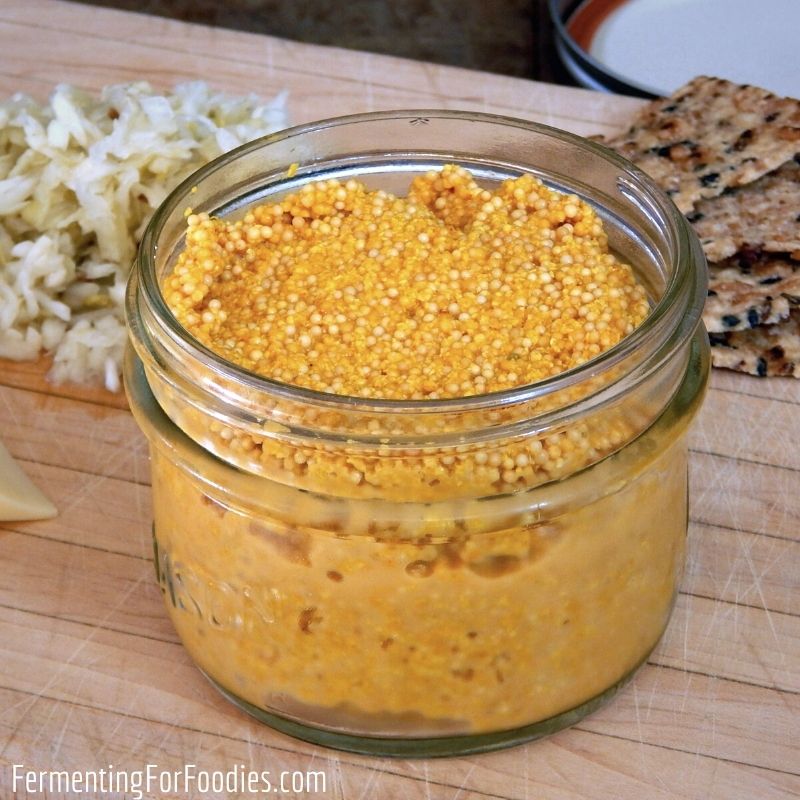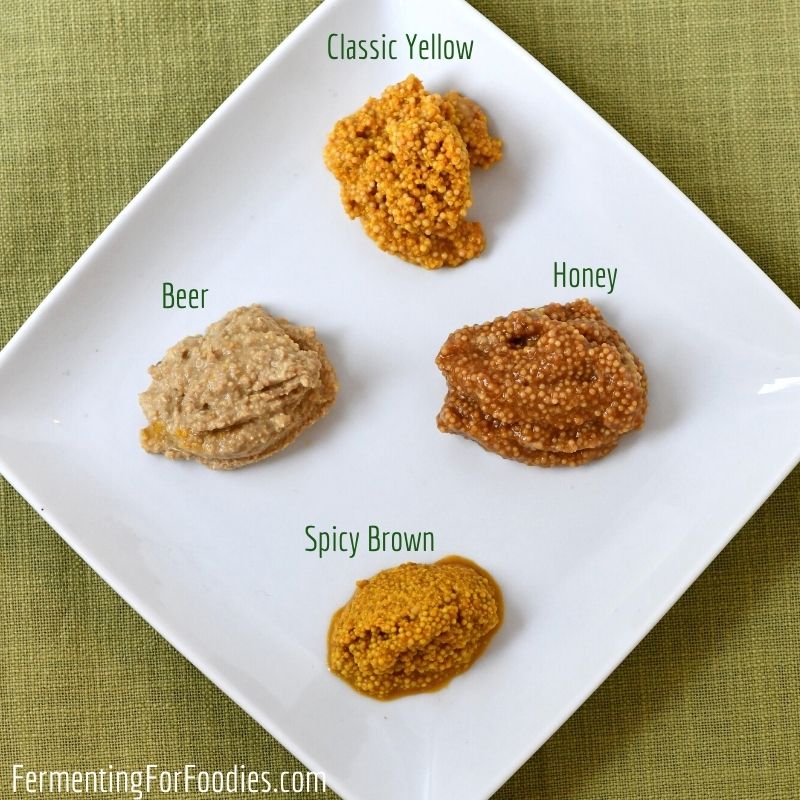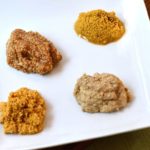Homemade mustard is a simple and delicious zero-waste swap. It’s perfect for hot dogs, sandwiches, and sauces! Made with apple cider vinegar-soaked mustard seeds, this delicious condiment will last for up to 6 months in the fridge.

Making mustard is very easy. After the seeds have soaked, it only takes about 5 minutes to put together.
Personally, I like the sophisticated look and taste of a few whole mustard seeds. However, you can grind mustard to a smooth consistency for classic squeeze-bottle style mustard.
Seven Mustard flavors
The recipe is for a super simple grainy mustard. Perfect for all your mustard needs. However, it’s also a great base recipe for all sorts of fancy flavored mustards!
Here are a few of my favorite flavors.
1. Classic Yellow Mustard
Classic yellow mustard is a favorite for hot dogs and sandwiches. It’s the type of mustard that usually comes in a squeeze bottle.
- To make homemade classing mustard add 1/2 tsp of turmeric, 1/4 tsp of sweet paprika, and 1/4 tsp of garlic powder during the grinding.
- Continue grinding the seeds until they turn into a smooth paste.
2. Honey Mustard
Homemade honey mustard is perfect for barbecues.
- To make honey mustard add a 1/4 cup of honey when grinding the seeds.
3. Beer mustard
Beer mustard is a great all-purpose mustard.
- To make beer mustard, replace half the cider vinegar with your favorite beer. Use a 1/4 cup of beer and a 1/4 cup of vinegar.
- If you find the beer to be too bitter, add 1 Tbsp of brown sugar to balance it with sweetness.
4. Hot Brown Mustard
Brown mustard seeds are much spicier than yellow mustard seeds.
- To make hot brown mustard, replace half of the yellow mustard seeds with brown or black mustard seeds.
- There’s no need to adjust the amount of vinegar. If it needs more liquid add more water while grinding.
5. Basil Mustard
I discovered basil mustard in a fancy gift store in Europe. I bought a small jar as a memento and loved it! The basil is subtle, but perfect with cheese.
- To make basil mustard, add 2 Tbsp of fresh basil while grinding the seeds.
6. Fruit Mustard
These next two recipes are a bit of a cheat. While they are based on this basic mustard recipe, they are enough of a variation that they deserved their own post.
Naturally sweet and spicy, fruit mustard is delicious in salad dressings or sandwiches. It involves adding fruit when you soak the seeds. Here’s my recipe for fruit mustard.
7. Dijon Mustard
Dijon mustard is a simple, yet posh variation on this basic mustard. Really it only involves replacing the vinegar with white wine! No added spices or flavors are necessary. Best of all, homemade Dijon mustard is sulfite-free!

Homemade Mustard
Homemade mustard is a simple and delicious zero-waste swap. Leave it grainy or blend it smooth. This simple recipe is a perfect base for all sorts of mustard flavors: hot brown mustard, classic yellow mustard, or beer mustard! See the sections above for more details.
- Prep Time: 15 minutes
- Total Time: 15 minutes
- Yield: 1 cup 1x
- Category: Condiment
- Method: Fermented
- Cuisine: British
- Diet: Vegan
Ingredients
- 1/2 cup yellow mustard seeds
- 1/2 cup cider vinegar
- 1 tsp salt (non-iodized)
- 1 to 2 Tbsp filtered water (optional)
Instructions
- Mix the mustard seeds with cider vinegar and water in a non-reactive glass dish.
- Leave the seeds to soak at room temperature for 24 hours.
- After soaking, add in the salt and any additional flavors (see the section above for options).
- Grind the seeds to the desired consistency using a blender or immersion blender. Add a bit of water if more liquid is required. The exact amount of liquid will depend on how finely ground the mustard is.
- Store the finished mustard in a glass jar in the refrigerator. Allow it to mellow for at least 2 weeks before using. It should last in the fridge for at least 6 months.
Notes
- The mustard will become less spicy over time so leave it to ripen in the fridge until the flavor suits you.
- If you don’t have a good blender, feel free to replace the mustard seeds with an equal amount of mustard powder. The flavor won’t be exactly the same, but it will save you from grinding the seeds!
- I recommend using cultured apple cider vinegar. Then the mustard seeds will ferment as they soak. This gives the mustard a longer shelf life. Look for brands that contain a mother or are labeled as raw.




Hello,
Thank you for the recipe. I am wondering is it possible to use fresh spices, such as fresh or dried ginger, turmeric?
//J
I think you could use fresh ginger and turmeric. However, it might not last as long in the fridge, so use it within a month. Sounds yummy!
I’m wondering about the apple cider vinegar – it doesn’t halt the fermentation process? I thought I read somewhere that vinegar’s acid could interfere with fermentation, but that may be wrong.
Acid will definitely affect a ferment. Most ferments acidify as they ferment. For example the bacterial profile of sauerkraut actually changes as it ferments from low acid-loving strains to high acid-loving strains. In this recipe I am using the cider vinegar for the ferment. Or at least to provide the probiotics in the mustard. It’s good to have it high acid to prevent other bacteria from culturing it, as mustard will last for months in the fridge.
Thanks, that’s very helpful!
This looks delicious and I can’t wait to try it!
Do you need to move it to the refrigerator? If so, when?
Thanks in advance!
I move it to the fridge when I’m finished fermenting (will add that to the recipe!) I since I started making this, I ALWAYS have homemade mustard in my fridge. It is so good, and I love grainy mustard.
Just put together the ingredients. Thanks for the vase recipe and ideas 🙂
Glad you like it! I love this recipe, and I honestly haven’t bought mustard in years. Well… except once when I was hosting a hot dog roast for kids, and figured I needed a squeeze bottle of regular mustard. 🙂
Base recipe, not vase! Duh.
Hi thanks for the recipe! for the ferment should I put a lid to the jar when fermenting for 2 days? Thanks!
Yes, you can use the jar lid or cloth. It won’t bubble like some ferments do. Enjoy!
Can I use ground mustard seeds instead of whole?, to make it even easier to make.
I haven’t tried ground mustard, so I’m not sure exactly what the ratio of powder to liquid would be. If you try it, let me know how it comes out. Thanks!
This post is a few years old but I’m trying it tonight for the first time. I followed the recipe and decided to check on it after just a few hours into the 48 hour ferment and all of the liquid has been absorbed. Do I add more ACV or water and let it sit the full 48 hours?
It’s fine if the seeds are above the liquid, but there still should be some liquid at the bottom of the jar. Just give it a stir once or twice and it will work out fine! If you add extra liquid it might end up being too liquidy. Enjoy.
awesome you posted this recipe!
i made the yellow mustard version, but instead of paprika i used organic ground black pepper. i hear, for tumeric to be properly absorbed in our bodies we need black pepper with it
i also make a version with organic karashi, its japanese mustard
with both, i add as well some yuzu juice from a fresh yuzu. i was thinking lemon but i live japan so maybe lucky, only had yuzu in my fridge. also, some raw honey
when ferment the mustard seeds, i add some fresh organic garlic, cut very fine. im sure its ok adding the garlic fresh to ferment like this
i really thank you for sharing these instructions. have a lovely day
Thanks for sharing! All of those flavor additions sound delicious. I’ve never had yuzu before. Yum!
Hi I made one of the base mustard recipes a couple months ago and it turned our great.
I tried the beer mustard variation this time; however when I pulsed the mustard after 48hr at room temp, it smells pretty bad.
Should I have done the ferment in the fridge due to the beer? And with no vinegar, how long is the mustard good for in the fridge?
Sorry to hear that! I’m surprised it went off. Mass-produced commercial beer wouldn’t actually ferment (so in the fridge is probably better). Artisan beer may have live yeast. And yeast can smell pretty funky when it ferments. I’ll test the recipe this week using 1/2 vinegar and 1/2 beer… which would help to increase the shelf life and may solve the issue around yeast fermentation.
Cheers, Emillie
Thanks I look forward to reading how it goes! I am going to let it sit for a week in the fridge and see how it looks/smells. I’m going to try another batch using the same ratios but ferment the seeds in the fridge this time to see if it does the same thing as well!
Great! I’ll let you know.
We made this beer mustard recently. Talk about winter comfort food with some homemade sausages! Thanks!!
Glad you liked it!
Hi! Is there anything I can use other than apple cider vinegar? Im very allergic to apples (and grapes). Thanks!
Probably the easiest option is kombucha (if you don’t brew it yourself, buy a locally brewed on that must be refrigerated). Other raw fruit vinegars that would work, but they can be difficult to find. Cheers!
hi, me again! is there a certain flavor of kombucha I should use? I can’t do Apple or grape. you’re right it is hard to find coconut etc vinegar ha.
Try for plain kombucha tea or something that would taste good with mustard, like berry-flavored kombucha. You could also use white vinegar, but it will have a more vinegary flavor. Good luck!